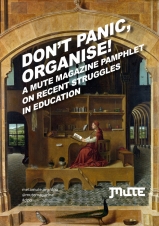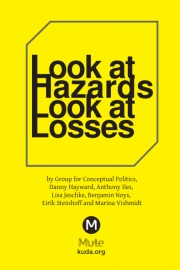A lack of trust spells crisis in every financial language - Credit crisis digest
Great to see the heads of mega banks fulminating against fiction and innuendo as a 'careless talk costs banks' ethos is pounded into their employees and rivals are threatened with retaliation for daring to speculate (ahem) on their illiquidity... a bit like the last season of The Wire, which is looking mighty prophetic in its articulation of the relations between lies, non-reproduction and the (more or less open) collapse of once 'great' institutions.
the piece below by gillian tett in the FT suggests how if credit is etymologically about trust, but susceptible to enormous quantities of structured and leveraged bullshitting, the current crisis ('worst in 80 years') spells systemic loss of faith in all the new tools for disseminating risk formerly held to be a totem against financial loss. a freudian dialectical inversion is turning the concatenated buffers and shock absorbers and phallus-protectors into a network of total exposure (terror is a network... after all). risk-evasion calculus backfiring on its architects leads to a more total loss of trust, exponential risk, the threat of contagion inflecting the most soothing words and all attempts - a la kerviel - to isolate the canker are transparently reifying, pure fetishes (freudian and marxian) making individuals or institutions responsible for a loss that is systemic...
time to short lehman and ubs, buy gold, and watch as the usa turns out not to have half as much resilience as japan in the 80s (cos unlike japan, it has no money of its own). meanwhile in germany (industrial) Siemens in trouble suggests how much the 'subrime problem' was just the first fetish, an opening denial-as-realisation unleashing the tidal wave of similarly skewed but irreversible realisations; could it be this contagion can affect the industrial and corporate as well as the financial sectors? is this really gangrene climbing up my leg? as northern rock axes 2000 jobs it should be clear that capital's next step, after denial, is to start hacking away at live flesh - and this wont just be in the fallguy institutions most obviously implicated in the opening act of the crisis such as northern rock.
time to think about how those who understand the depth of this crisis in historic terms - ie not 2002, 98,91, 73 but 29 (or worse) - should act, given not just capitalist panic but the global weakness of the working class and the utter lameness of most of the left. if the era of moral alternatives to capital is over, or rather about to go into hysterical, 1930s style overdrive, how do we survive this and organise to ensure that capital does not?
last time things got this bad the 'advanced' capitalist nations had an industrial base, there were factories to devalorise workers and extract value in - today? and last time, workers had organisations in which to respond to this process - without the dubious totem of union bureaucracy the working class may be as vogelfrei and exposed as the capitalists, but this is more likely paralysing than energizing, and the depth of isolation here is real, not just a fetishistic conceit of the spin doctors.
time to start making networks that are set on more than a moral overhaul or technical upgrade of the system? time of the assassins?
xxxxxxxxxxxxxxxx
ADVERTISMENTCrisis in the Credit System? Trouble sleeping? Try music:*http://profile.myspace.com/index.cfm?fuseaction=user.viewprofile&friendID=230275693
*May cause sleeplessness
xxxxxxxxxxxxxxxxx
Bear Stearns: The domino effect? The doomsday scenario is that the collapse of Bear Stearns is just the first in a series of devastating banking failures. But how do we spot the nextvictim of the credit crisis – and will thereeven be one? By Stephen Foley The Independent
Wednesday, 19 March 2008
Fancy a game of dominoes? It has been the pursuit of choice on Wall Street for the past week, after Bear Stearns began its death spiral, the one question on everyone's lips. Which bank is next?
On different days, there have been different answers. Lehman Brothers, most often. UBS, perhaps. For the first time yesterday, the most common answer was: no one.
Where investors had been bracing themselves for horrors in the latest round of quarterly financial results from brokers, the figures yesterday from the first two out of the traps – Lehman and Goldman Sachs – proved a little less bad than feared.
More importantly, executives at both banks focused heavily on setting out just how much cash and liquid assets they have on the books, relative to their short-term trading liabilities.
The collapse of Bear Stearns has changed the picture, in two important ways. Firstly, the Federal Reserve has learnt what to do. As well as promising to underwrite JPMorgan Chase's takeover of Bear, it has re-activated a Depression-era rule allowing securities firms to borrow directly from the Fed.
Bear couldn't do that, meaning it had nowhere to go to offload the illiquid mortgage securities its toxic balance sheet was laced with. Any bank in a jam from now on will be able to go directly to the Fed's discount window and trade in its hard-to-sell assets as collateral for highly liquid government bonds or cash, which it can in turn use to fund its short-term liabilities and keep trading.
Secondly, Bear's rivals have learnt what not to do. The hapless Alan Schwartz, chief executive of Bear, fulminated about the "fiction" and "innuendo" scaring clients and trading partners away last week, but in neither his stock exchange statement insisting all was well on Monday, nor his television appearance on Wednesday, could he offer more than broad-brush promises that Bear's liquidity position was strong.
Lehman Brothers was touted last week as the "next weakest" of the Wall Street titans, a close rival of Bear and also one of the leading players in mortgage-related derivatives and in other esoteric corners of the battered credit markets.
But in the last few days, and again on a conference call with investors and analysts yesterday, Lehman has provided a masterclass in how to prevent stock market rumours from turning into a crisis of confidence that engulfs the bank. To borrow a phrase: education, education, education.
Traders at Lehman were issued with a list of "talking points" last week, advising them on the details of the firm's liquidity position and suggesting some reassuring things to say if a trading partner was considering pulling its business. If anyone really did pull their business, there would be calls between more senior executives of the two institutions and a lot of cajoling to get the business back. Over the weekend, regulators also appear to have stepped in, and the Federal Reserve bank of New York is understood to have put out the word that spreading rumours about a rival's liquidity position would be viewed as tantamount to market abuse.
Across Wall Street, banks have put in place "rapid response" strategies that have echoes of a political campaign machine. When Meredith Whitney – the bearish financial sector analyst from Oppenheimer & Co, whose star has been in the ascendant since she correctly predicted Citigroup would have to cut its dividend – was playing dominoes on business television yesterday, she answered a question on who might be most a risk of being "the next Bear" by pointing to UBS. Within minutes, UBS officials were in email contact with her, to question her reasoning and correct what they said were mistakes she had made.
Lehman has insisted to anyone who would listen that it learnt useful lessons from the financial markets crisis of 1998, when the Russian debt default caused a convulsion in the credit markets that caused it massive losses, raised questions of its future and almost triggered a run on the bank. The company is much more conservative in its liquidity position, more diverse and, crucially, more pro-active in informing the market about its finances, Lehman chief executive Dick Fuld said in a string of interviews.
Yesterday, Lehman said it earned $489m in the three months to the end of February. That is a vicious haircut from the $1.15bn in the same period last year, but that was when the credit market bubble was at its most expansive. Even the mighty Goldman posted a similar 50 per cent collapse in earnings yesterday, in what its chief executive, Lloyd Blankfein, called "very difficult" market conditions.
Lehman cut the value of its holdings of mortgage-related derivatives, commercial real estate interests and leveraged loans by $2.4bn, but that was not a shock to analysts who have seen all these markets weaken sharply since the start of the year.
Most important of all, on its call with Wall Street analysts yesterday, Lehman's chief financial officer Erin Callan went beyond the end of its financial rep-orting period and set out the business's liquidity position as of the previous evening. "We have structured our liquidity framework for a decade to cover expected cash outflows for 12 months. And we do so without expecting to be able to raise new cash in the unsecured markets, or without having to sell assets."
And Ms Callan concluded the call by thanking analysts for supporting the company – a nod to the ease with which inaccurate or loose comment can cause serious crises of confidence.
Analysts themselves had been painstakingly picking through the minutiae of the balance sheet statements from the major finance houses, looking at liquidity ratios (that is, the amount of cash and liquid assets versus short-term liabilities) and coming up with their mathematical version of dominoes. Merrill Lynch "riskiest after Bear" was the headline one news agency put on news of one analysis by Wachovia's Douglas Sipkin, which pointed to Merrill's $30bn exposure to sub-prime mortgage derivatives and its top-of-the-industry level of leverage.
However, Mr Sipkin does not mean to suggest a run on Merrill is likely. "We believe going concern fears regarding the investment banks are misguided. While liquidity conditions are more challenging than at any time in recent history, the failure of Bear Stearns was more a management issue than a market issue, in our opinion. In addition, we view the Fed's action which allows dealers to access the discount window as a major development in the liquidity freeze saga for investment banks."
Still, not everyone agrees that Bear Stearns will certainly be the last major casualty, since the additional writedowns announced by Lehman and Goldman yesterday show that there is no clarity yet on the losses feeding through the system from defaulting mortgages and falling US house prices.
Paul Niven, head of asset allocation at F&C Investments, said: "While we take comfort from the proactive policy response being undertaken by the Federal Reserve, investors need to see evidence of its effectiveness to avoid speculation that the US is falling into a Japanese-style liquidity trap. This all leads towards heightened levels of volatility remaining in financial markets over the coming quarters."
Wall Street fears for next Great Depression By Margareta Pagano, Business Editor Sunday, 16 March 2008
Wall Street is bracing itself for another week of roller-coaster trading after more than $300bn (£150bn) was wiped off the US equity markets on Friday following the emergency funding package put together by the Federal Reserve and JPMorgan Chase to rescue Bear Stearns.
One UK economist warned that the world is now close to a 1930s-like Great Depression, while New York traders said they had never experienced such fear. The Fed's emergency funding procedure was first used in the Depression and has rarely been used since.
A Goldman Sachs trader in New York said: "Everyone is in a total state of shock, aghast at what is happening. No one wants to talk, let alone deal; we're just standing by waiting. Everyone is nervous about what is going to emerge when trading starts tomorrow."
In the UK, Michael Taylor, a senior market strategist at Lombard, the economics consultancy, said on Friday night: "We have all been talking about a 1970s-style crisis but as each day goes by this looks more like the 1930s. No one has any clue as to where this is going to end; it's a self-feeding disaster." Mr Taylor, who had been relatively optimistic, has turned bearish: "It really does look as though the UK is now heading for a recession. The credit-crunch means that even if the Bank of England cuts rates again, the banks are in such a bad way they are unlikely to pass cuts on."
Mr Taylor added that he expects a sharp downturn in the real UK economy as the public and companies stop borrowing. "We have never seen anything like this before. This is new territory for us. Liquidity is being pumped into the system but the banks are not taking any notice. This is all about confidence. The more the central banks do, the more the banks seem to ignore what's going on."
Mr Taylor added that the problems unravelling at Bear Stearns are just the beginning: "There will be more banks and hedge funds heading for collapse."
One of the problems facing the markets is that, despite the Fed's move last week to feed them another $200bn, the banks are still not lending to each other.
"This crisis is one of faith. We are going to see even more problems in the hedge funds as they face margin calls," said Mark O'Sullivan, director of dealing at Currencies Direct in London. "What we are waiting for now is for the Fed to cut interest rates again this week. But that's already been discounted by the market and is unlikely to help restore confidence."
Mr O'Sullivan added that the dollar's free-fall is set to continue and may need cuts in European interest rates to trim the euro's recent strength against the dollar. "But the ECB doesn't like cutting rates," he said.
On Europe, Mr Taylor said that while the German economy remains strong, others such as Italy's and Spain's are weakening. "You could see a scenario where the eurozone breaks up if economies continue to be so worried about inflation."
European financial markets were relatively unscathed by Wall Street's crisis but traders expect there to be a backlash when stock markets open tomorrow.
The Fed's plan will give 28 days of secured funding to Bear Stearns, which saw its value slashed over the week by more than a half to $3.7bn. JP Morgan will provide the funding, but the Fed will bear the risk if the loan is not repaid. Fed chairman, Ben Bernanke, who pumped $200bn of loans to cash-strapped institutions last week, said more would be available to help others in distress.
A lack of trust spells crisis in every financial language By Gillian Tett Published: March 18 2008 02:00 | Last updated: March 18 2008 02:00
http://www.ft.com/cms/s/0/928d490a-f48c-11dc-aaad-...
In recent years, bankers have succumbed to the idea that the credit world was all about numbers and complex computer models. These days, however, this assumption looks ever more of a falsehood.
For as anyone with a classical education knows, credit takes its root from the Latin word credere ("to trust") And as the current credit turmoil now mutates into ever-more virulent forms, it is faith - or, rather, the lack of it - that has turned a subprime squall into a what is arguably the worst financial -crisis in 80 years.
Make no mistake: what we are witnessing right now is not just a collapse of faith in one single institution (namely Bear Stearns) or even an asset class (those dodgy subprime mortgage bonds). Instead, it stems from a loss of trust in the whole style of modern finance, with all its complex slicing and dicing of risk into ever-more opaque forms.
And this trend is not just damaging the credibility of banks, but the aura of omnipotence that has enveloped institutions such as the US Federal Reserve in recent years. The credit world, in other words, now lacks credit - in the original meaning of "he/she trusts".
The most graphic illustration of this can be seen at Bear. Just a week ago, this was an institution with a book value of about $80 a share, if you believed the way that computers were valuing Bear's complex credit products. Moreover, its top executives categorically denied that the bank faced any liquidity squeeze.
But now JPMorgan is paying just $2 a share to purchase the once mighty Bear and its towering mountain of mortgage assets. Meanwhile, the Fed has indicated that Bear's liquidity position is so bad it needs a $30bn (€19bn, £15bn) safety net to keep its operations running without roiling the derivatives -markets.
This has scary implications for other investors holding banking shares or mortgage assets like those owned by Bear. Judging from publicly reported accounts, there is no reason to believe that any other large US or European bank should implode. And in the last 24 hours, every bank executive worth his or her salt has been telling counterparties that they are awash with liquidity. Meanwhile, policymakers have been quietly spinning - in carefully reassuring tones - the message that Bear was an "isolated case".
But the problem is that nobody quite believes official financial spin any more. Thus the Fed is caught in a peculiar policy trap. On the one hand, the market wants the US authorities to take radical steps to counter the liquidity squeeze, such as making more rate cuts; but on the other hand, when the Fed does produce dramatic action, this merely confirms the sense of crisis.
Of course, the good news is that history shows that eventually this storm - like all others before - will come to an end. Better still, one factor that might hasten such healing is that by many measures, the global financial system is still cash rich. Never mind the bulging coffers of sovereign wealth funds; there are also huge pockets of money sitting in mainstream pension funds and with other mainstream western asset managers right now.
Thus, the desperate hope of many policymakers - and bankers - is that if confidence in the system can only be stabilised for a while, funds should eventually flow back into credit markets again as investors move to snap up bargains. If so, that should ease the current crisis faster than anyone can say the word "bail-out".
But do not expect to see that salvation happen too soon - and possibly not without further US government intervention, perhaps in the form of a decision to make state purchases of troubled mortgage assets. After all, what makes the current crisis so pernicious is not simply that it is severe, but that it is also unpredictable.
More specifically, banking has become so complex and opaque in recent years, as a result of financial innovation, that when shocks occur in one obscure corner of finance this creates all manner of unexpected chain reactions. This makes it hard for policymakers to formulate policy - and even harder for ordinary investors to predict what might happen next.
No wonder so many asset managers have been scrambling to buy in sectors such as government bonds or gold. After all, gold has the compelling attraction of being easier to understand than a mortgage bond; better still, it has existed long before even the Romans.
In the last resort, in other words, the key to resolving this crisis will not lie with just the injection of billions more of central bank dollars; instead what is needed is the restoration of credit, in the most basic, faith-based sense.
But rebuilding trust will emphatically not be an easy task. Brace yourself for more turbulent days - in whatever language you choose.
Mute Books Orders
For Mute Books distribution contact Anagram Books
contact@anagrambooks.com
For online purchases visit anagrambooks.com






